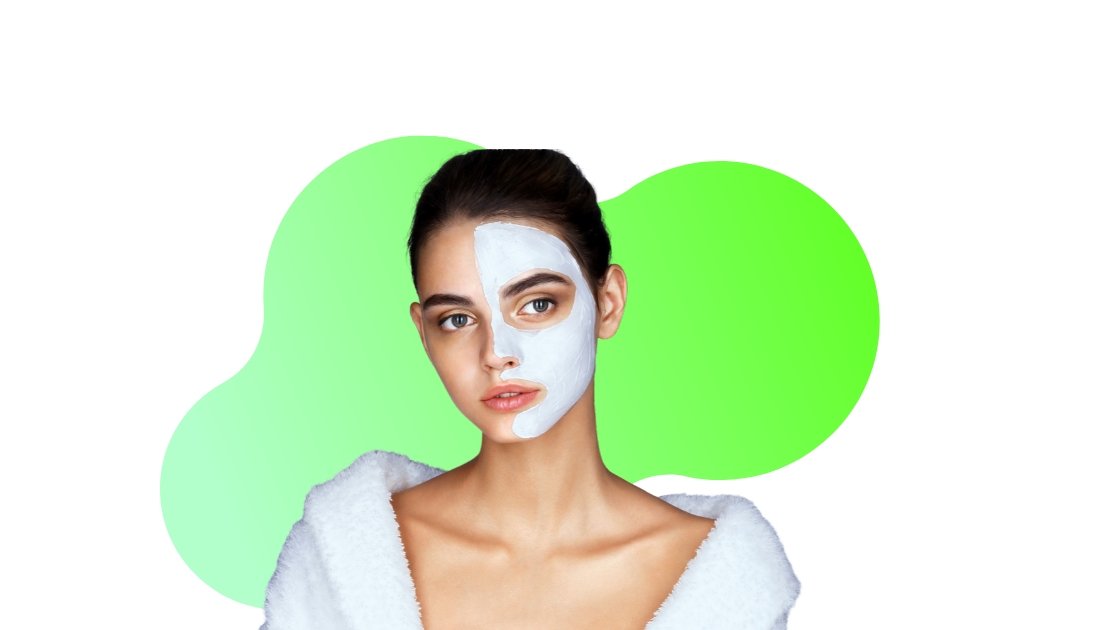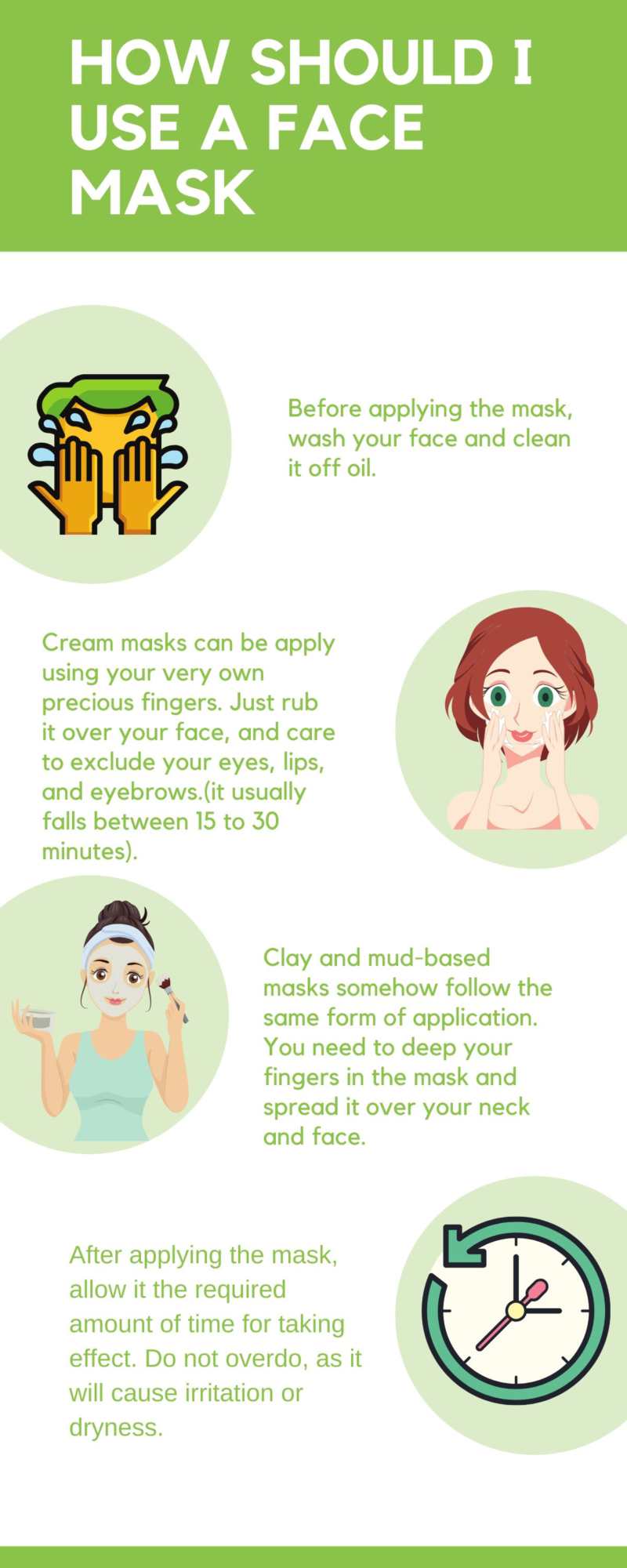The Beginner’s Guide to Facial Masks
The Beginner’s Guide to Facial Masks : Face masks were the gateways to the world of beauty and skincare for me, as I was growing up. But when it came the time for me to actually list them in my skincare habits, I didn’t know where to start. I know it sounds clumsy, but with the aisles full of different kinds of face masks, who does at first?
We have consulted recent research on facial masks and all that’s related to them. Here is all you need to know about masks in general and for the beginning. I just can’t help wondering if you knew what goes into their making. Read on and let us know if this was helpful for you.
Are masks recent inventions?
Much to your surprise, no. Drowning the skin in nutrients for a certain amount of time for beauty and health is an ancient practice. Cleopatra is almost famous for her milk baths, taken to sooth her skin and give her the fairness of her looks.
A variety of practices have been developed for both the face and the body all along the way. The most recent proof of this is the upswing of social media contents related to DIY natural face masks and skincare hacks.
But how do masks work?
A facial mask has a high concentration of ingredients useful for the skin. It is layered over the face for about 10-20 minutes in order to allow the ingredients enough time for penetration and achieving the desired effect.
Even though this sounds interesting, the effect of a facial mask is only temporary. It can be used for a quick inflammation and acne fix, providing hydration, or simply to boost the effect of other materials you use on a daily basis.
What’s more, you cannot use a mask everyday as it might lead to unforeseen issues such as allergies, inflammation, irritation, dryness, etc. Masks need to be used once or twice a week; besides the everyday products you use for skin care, and in order to boost the function of other products.
What are the types of masks?
Well, masks are not only used for the body, neither are they prepared for only skincare purposes. In addition to your hair, you can use the benefits of masks for your body and hair. The body masks can include clay-based, wax-based, cloth-strip products as well as mud baths.
These masks are normally used for scrubbing, exfoliation, and moisturizing the skin. Meanwhile, hair masks also come in different consistencies such as clay or gel, used for hair conditioning or treating the scalp.
Also, the medical usage of masks in dermatology has proven useful in various cases. A variety of issues such as psoriasis, acne, eczema, mycoses, seborrhea, etc. are addressed with the nutrients and compounds.

Let’s talk consistencies, shapes, and purposes.
What are the types of face masks out there? You might have found it puzzling to choose just one kind of mask. Do you know which is which and what they are use for? If yes, hats off to you. If no, then you’d better know that self-applied masks sold in the market generally fall under 4 categories:
- Clay based masks which dry on the surface of the skin
- Polymer base masks which are remove peeling when they dry over the skin
- Therapeutic masks which contain active ingredients in order to address certain issues on the skin
- Dual purpose masks which exfoliate the skin
In common terms, you also will find creams, sheets, clay, gels and mud as different types of masks in the market.
These masks can be apply for a variety of purposes. For example, masks are known to increase hydration, shrink the size of the skin pores, cause exfoliation, and control the amount of sebum produced by the oil glands. So, your choice of product relies on your goal and the ingredients included in it.

The ingredients of facial masks matter.
Depending on the result expect from the mask, a variety of ingredients may be includ in its formula. According to a research conducted by dermatologists Baron, Howard, and Maibach, “popular featured ingredients for facial mask formulas include mineral salts, botanical oils and extracts, menthol, magnesium sulfate, zinc sulfate, oatmeal, rice bran, aloe vera, and both alpha and beta hydroxy acids as exfoliants or anti-acne agents”.
More specifically, masks which are intended for acne treatment include active ingredients like benzoyl peroxide, salicylic acid, or sulfur. The same research points out that a variety of base and scrubbing agents can be use for exfoliation.
It enumerates the use of polyethylene beads, “wax capsules with protease, lipase and muramidase enzymes, ornithine derivative-coated microspheres of vinylidene chlodride/acrylonitrile copolymer as exfoliants, and gel spheres of beta 1,3-diglucan as scrubbing agents”.
Balancing the proportions of these materials is important for preventing irritation and controlling the exfoliation degrees.
But you would be mistake to think this is all. In fact, the deeper you dig into the world of facial masks and skincare products, the more detailed formulas and more targeted their functions become.
For example, you will find a combination of the glucooligosaccharides extracted from beetroot and corn sugars and alpha hydroxy acids included in a kind of mask to maintain the skin’s stratum corneum and its quality as a barrier.
It might be interesting for you to know that the biggest challenge posed by natural products used as physical as and base materials, especially in scrub masks, is keeping a tap on the microorganisms that can potentially contaminate the formula, the durability of the product, and its preservation.
Also, I couldn’t emphasize the importance of knowing what does or doesn’t work on your skin. As a rule of thumb, try to avoid products with fragrance, dyes, paraben, alcohol, and essential oils. These materials tend to over dry the skin and cause allergies, especially on sensitive skin.
Can I trust the next face mask and apply it right on?
Besides the ingredients of a mask, your skin plays a major role in the effectiveness. So, the answer to the above question is no. Your response to the ingredients is what you need to watch in the first place.
It is determine your skin type, specific issues you may be experiencing with your skin, ethnicity, the environment, and your body’s reaction to allergens and irritants.
In order to prevent this, you need to identify your specific skin sensitivities and check the ingredients with their doses on the product’s packaging. Sometimes, performing a little patch test on your wrist may also prove helpful. In the best-case scenario, you should allow 48 to 96 hours for symptoms of allergy to show.
If no signs of irritation appear, the mask is good to go.
Are face masks essential for a skin care routine?
The condensation of nutrients and compounds applicable for medical purposes make facial masks an appealing addition to your skincare routine. Now, with ‘addition’ I definitely mean that it is better not to use it on a daily basis. Rather, you will potentially see remarkable results if you only use the mask once or twice a week, besides your normal routine.
So, in case you were also wondering ‘how often should you use a facial mask?’, I’d say twice a week at most. Just pamper yourself with it and let it perk up the effect of everything else you do on a daily basis.

How should I use a face mask?
Okay it is needless to say using different types of masks may require you to follow a slightly different instruction. Besides this, you need to take certain steps before and after every time of use.
- Before applying the mask, wash your face and clean it off oil and impurities that might be blocking the way of nutrients. Make sure to dry it completely afterwards.
- Cream masks can be apply using your very own precious fingers. Just rub it over your face, and care to exclude your eyes, lips, and eyebrows. Follow the product’s instructions for the required time to allow it on your face then rinse or peel it (it usually falls between 15 to 30 minutes).
- Clay and mud-based masks somehow follow the same form of application. You need to deep your fingers in the mask and spread it over your neck and face. Start at your upper neck and continue rubbing the mask upwards, until it covers all areas of your face, except your eyes and lips.
- Scoop out gel masks with your fingers and spread the material evenly on your face, but avoid your eyes and lips.
- Remove a sheet mask from its package and unfold it carefully, in order not to tear it. Adjust the mask according to the shape of your face and gently press.
- After applying the mask, allow it the required amount of time for taking effect. Do not overdo, as it will cause irritation or dryness.
For peel off masks as well as sheet masks, you need to be patient and gentle while removing the mask. Usually, you don’t need to rinse your face after applying a sheet mask. Instead, you can go ahead with your skincare routine.As for the rest of the masks, you need to use lukewarm water in order to rinse off the mask.
Don’t rub or scrub your face too hard. Make sure to clean your face completely and then gently pat it dry. Using a moisturizer in the end is a must, for achieving the best effect possible and preserving your skin’s hydration.
FAQ
Are facial masks good for your skin?
Although there is no independent evidence that mud masks, clay masks, cream masks, or sheet masks provide any long lasting benefit to the skin, they can be hydrating, soothing and provide some keratolytic/exfoliant effect — if only in the act of removing them, Dr. Lortscher explains.
Can I use face masks everyday?
If you have oily or combination skin, limit use to a couple of times a week as it could be too heavy. ... These masks can typically be used daily (especially if your skin veers on the dry side). Even if you have oily skin, you can be dehydrated so try using a mask with humectants once a week.
What is the best facial mask to use?
Here are the best face masks:
Best face mask overall: Fresh Umbrian Clay Pore Purifying Face Mask.
Best soothing face mask: Kiehl's Calendula & Aloe Soothing Hydration Masque.
Best sheet mask: SK-II Facial Treatment Mask.
Best overnight face mask: Laneige Water Sleeping Mask.




